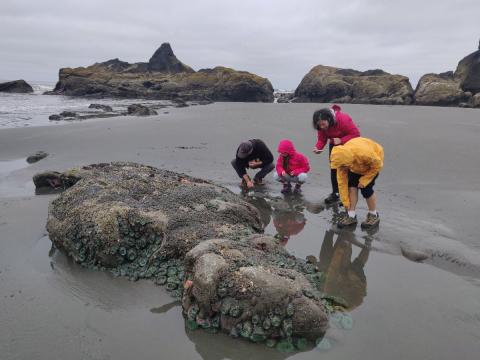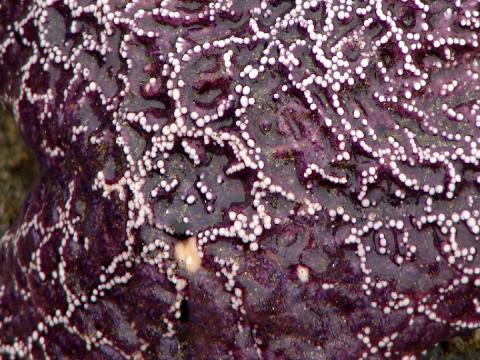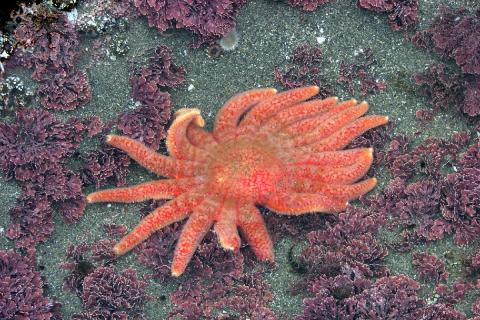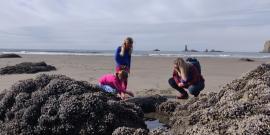
Discover Colorful Animals & Seaweed in Tidepools with a Marine Biology Teacher.
The Pacific Coast and Salish Sea are in a sweet spot for intertidal diversity that includes sponges, sea anemones, marine worms, molluscs (chitons, limpets, marine snails, nudibranchs, bivalves, octopuses), barnacles, crabs, sea stars (aka starfish), urchins, sea cucumbers, tunicates, fish, surf & eel grass, and seaweed (green, red, or brown including kelp).
Tidepools (also known as rock pools) can be described as semi-permanent pools of water that create safe zones for viewing delicate intertidal organisms. The outstanding biodiversity in Olympic National Park tidepools is due to many factors including geology, marine climate, and wave action.
Timing and Accessibility of Olympic National Park Tidepools
Not all beaches provide good guided tidepooling and tide predictions do not always reflect reality on the ground. Consider hiring Carolyn for a private guided tidepooling half day tour, which could end of being a favorite family and individual experience.
Olympic National Park tidepools may only be visible for a few hours a day at low tide from roughly late April to early September. Access to tidepools often occur over multiple days for a few hours in the morning based on the gravitational pull of the Sun, Moon, and Earth on the ocean so hiring a guide helps you time this biodiversity extravaganza.
The only truly accessible Pacific Coast tidepools are in the Feiro Marine Life Center in Port Angeles.

Guided Tidepool Tours Can Be Organized For All Ages
Although we have to walk in order to reach tidepooling beaches, we generally do not climb on rocks. Older adults and small children with stamina and balance will enjoy these guided marine experiences. Tidepooling is usually a favorite with families and for children six and older.
Whenever possible, we stick to sandy beach areas and look in tidepools and on the vertical surfaces of rocks. Children under the age of six may not be as interested as older children. If your kids love activities like Easter Egg Hunts, they will probably love a guided tidepooling tour!
Hiking (aka trekking) poles help to navigate slippery trails, beach logs, and areas where you must climb on rock.
Why Hire a Marine Biology Guide for Great Tidepooling Experiences
Without a marine biology guide to point out many of the small, cryptic, and camouflaged intertidal organisms, you will walk right by (or might step on) some of the most amazing intertidal invertebrates such as a wandering meatloaf, otherwise known as a Gumboot Chiton.
We might only be able to view the tunnels, eggs, scat, or molts of different marine species depending on the time of year.
A knowledgeable guide demonstrates responsible behavior in the hopes that future generations can enjoy these amazing threatened biodiversity hotspots.
Olympic National Park's Coastal Tidepools
If you only have one day to hire a marine biology guide, we recommend visiting the Olympic National Park Coast where we can walk on sand, observe tidepools in the sand and rock, and view common sea stars. We will walk for less than a mile through a Sitka Spruce-dominated forest, view offshore islands and seastacks, ocean wave action, and large stretches of wilderness beach littered with giant beach logs.
We try to visit tidepooling area with less concentrated human impacts. Also, tidepools in the shadow of islands or large rocks helps protect marine life from extreme heat events.
Olympic Peninsula's Salish Sea Tidepools
The Strait of Juan de Fuca connects the Pacific Ocean with the Salish Sea (our region's inland sea made up of Puget Sound, Strait of Georgia, Johnstone Strait, Hood Canal, and the Strait of Juan de Fuca itself). It is easier to observe far more diversity of shellfish, crabs, snails, barnacles, sponges, fish, surf and eel grass beds and all manner of seaweeds in the comparatively protected Salish Sea compared to the Pacific Ocean.
Urchins have replaced sea stars in many of these sites; in fact, finding any sea stars in the Salish Sea has become more challenging due to Sea Star Wasting Syndrome which we will explain in more detail below.
Ochre Sea Star (Starfish)
Pisaster ochraceus , also called the Ochre Sea Star or Common Sea Star, is a large five-arm star that is orange, purple, or brown, feels hard to the the touch, and has raised white ridges. The central disc of this species is quite large compared to other similar looking species. Although the Ochre Star is common on the Pacific Coast, it was never as common in the Salish Sea and now is even more difficult to find.
Sea stars like the Ochre Star and Pycnopodia (the Twenty-Arm Star) are considered keystone species, which means that they play an important role in the structure of the marine intertidal community. The explosion of sea urchins in recent years, an herbivore (plant eater), is a consequence of the die-off (extirpation) of carnivores (animal eater) like sea stars due to Sea Star Wasting.
Sea Star Wasting Syndrome
Sea Star Wasting Syndrome is a well studied but not well understood plague that largely impacts sea stars and has recently decimated certain species from Alaska to Mexico. Since Experience Olympic started operating guided tidepool tours in 2013, changes to the marine ecosystem have been intense and difficult to put into words. This disease outbreak is among one of the worst ever wildlife die-offs from Alaska to Mexico.
The large predatory twenty-arm star called Pycnopodia helianthoides has been practically extirpated from the Salish Sea over the past decade. Pycnopodia is a large predatory star that moves quickly compared to other sea stars and used to be fairly commonly observed in the Salish Sea. Pycnopodia largely preys on urchins. Urchin populations are now so high in the Salish Sea that they are impacting kelp forests.

Impacts of Human Foot Traffic & Extreme Heat
In heavily visited tidepooling areas, mussel beds on horizontal rock surfaces where people walk have transformed into largely barren rock surfaces with a few scattered small barnacles or slippery bare rock. Extreme heat events also bake exposed rock surfaces during low tide events.
We therefore try to walk on sand and avoid walking on rocks whenever possible to minimize our impact to these fragile intertidal biodiversity zones. Many small intertidal animals are hard to see and any seaweed that is growing on rock is alive and vulnerable because of the air-filled floats that keep the blades of seaweed on the surface of the water for photosynthesis.
Impact of Dogs on Wildlife Sightings
Dogs, especially those that are not on leash, can scare away River Otters, Raccoons, Columbian Black-tailed Deer, roosting gulls like the Short-billed Gull, and other commonly viewed beach wildlife. Ruby Beach, the best of the Kalaloch beaches, used to be a great place to view river otters.
In wilderness areas where dogs are allowed on a leash, they can and do end up off-leash. Once you commit to bringing a pet on a trip to Olympic National Park, a conflict can arise as almost all national park trails are closed to dogs.
A sign in the Hoh Rainforest states the facts best, "Dogs are natural enemies to all creatures of the forest. For the protection of your pet, as well as yourself and other hikers, pets are not permitted on trails."
Olympic National Park Marine Life found in Tidepools
Below we list general information about marine intertidal life of the Olympic Peninsula to help you savor the diversity of Olympic National Park and Olympic Peninsula tidepools.
The Orange Finger Sponge surrounds a Giant Acorn Barnacle. Sponges are the simplest intertidal animals. A Red Encrusting Sponge is surrounding a yellow Compound Tunicate. Giant Green Anemones are shown both in and out of the water.
The Velella velella stranded on the beach is actually a floating hydroid and not a true seajelly (sometimes called "jellyfish"). It can wash ashore in large number but can quickly dry out and disappear. The Northern Feather-duster Worms' durable tubes, which protect the brightly-colored worms, are often the only visible part.
Chitons are molluscs with eight shell plates (valves) and soft connective tissue (girdle). Small brightly-colored Lined Chitons have zig zag lines on the plates and the large red Gumboot Chiton has no visible plates. The two Mopalia sp. and the Black Katy Chiton look superficially similar. The Black Katy Chiton is nestled in the middle of a colony of Aggregating Anemones.
The Rough Keyhold Limpet, pictured at about five o'clock from the Purple Urchin, is a gastropod that has a round central hole. Gastropods, limpets and snails, are named for their muscular "foot". Both Gastropods and Urchins feed on seaweed. The ten Nucella sp. snails are scattered among three of their own yellow egg masses.
Nudibranchs or sea slugs are grouped with molluscs but most lack shells. Nudibranch means "naked gills". Rather than tentacles, they have rhinophores that help them sense chemicals. The Dorids, which include the Red-gilled Dorid and the Spotted Leopard Dorid have distinct circular gills opposite the rhinophores.
Two species of Sea Lemon occur here, the more common Monterey Sea Lemon, is shown in the series of photos with egg cases. The Noble Sea Lemon is less common and has black speckles between the tubercles. The Red Sponge Nudibranch, another Dorid, gets its birght color from eating the red sponge.
Nudibranchs like the all white Frosted Nudibranch and the Aeolids like the Thick-horned Nudibranch have projections off their back called cerata. The Thick-horned Nudibranch and other Aeolids extract the stinging cells from their prey and use them to repel predators. The cerata on the Thick-horned are often tinged in bright orange.
Mussels and Barnacles can tolerate living in higher intertidal zones where there is more exposure to the elements but fewer predators like sea stars. The large reddish brown California Mussel, a bivalve mollusk, is pictured as just an empty shell. White and Black Goose Barnacles are arthropods, more similar to crabs and shrimp than to mollusks.
Barnacles are arthropods and like crabs must molt (shed their exoskeleton) in order to grow. They permanently attach their head to rock and their cirri are modified legs that sweep the water to collect plankton as food. Pictured are the Giant Acorn Barnacle and a colony of Black and White Goose Barnacles.
The Isopods are a group of Arthropods that somewhat resemble pill bugs. They are often found in protected rocky areas like sea caves, seaweeds, and mussel beds. Pictured is the common Oregon Pill Bug whose brown body is oval and flattened and Vosnesensky's Isopod reddish brown color is similar to kelp.
The only amphipod we have pictured is a California Beach Hopper. They can be found on fine sandy beaches with other species of beach hopper but this one is distinctive as the adults have huge bright red or orange antennae that are longer than the body. The only shrimp species pictured is the Bay Ghost Shrimp that is held by a young tidepooler. One claw is significantly bigger than the other.
Crabs are a joy for children in the tidepools but should be observed and returned to their homes where they were found. The Flat Porcelain Crab hides in half of a bivalve shell. And the Granular Claw Crab hides in a hole.
Shore crabs are some of the most commonly viewed crab species on rocky shores on the Olympic Peninsula. Pictured are the more common Purple Shore Crabs, shown in its green phase as well. The Striped Shore Crab is slightly different with subtle stripes and is much more aggressive than the Purple Shore Crab. We do not handle the Striped Shore Crab as their pinch hurts.
The Graceful Decorator Crab pictured has a white carapace and white claws with long, thin parallel horns. Northern Kelp Crab is mostly reddish with a shield shaped carapace that is smooth. They are also called spider crabs because of their long legs and are usually found in surfgrass. Surf grass grows on rock and eel grass grows in sand, both are true plants.
Although the Red Rock Crab is superficially similar to the Pygmy Rock Crab, the two live in different habitats are are different sizes. The Red Rock Crab is in the low intertidal zone so rarely observed while tidepooling whereas the Pygmy Rock Crab is so small that it is often found hiding in empty Giant Barnacle and Piddock holes.
Like sponges, Bryozoans look like seaweed but are actually animals. A colony of bryozoans contain thousands of individuals.The tan colored Branched-spine Bryozoan looks a bit like a fleshy coral and is attached to a rock. The Kelp Encrusting Bryozoan is a small circular colony crust that grows on seaweed an in this photograph on a red seaweed.
The Sea Stars (sometimes called "Starfish") are a class in the Phylum Echinodermata and a favorite of tidepoolers. Although we mostly observe the Common Star, we might see other species of sea star that usually occur in subtidal zones. A large fat 5-arm Leather Star looks a bit pock-marked mottled red and blue-gray. The Striped Sunstar has 8-11 rays and is orange with a gray stripe running from the center and down each arm.
The Pacific Blood Star is a bright red star that is hard to miss. A related species, the Dwarf Mottled Henricia is a newly described species, smaller and mottled. Both are Henricia genus. The Mottled Star is more similar to the Common Star but has a much smaller central disc.
The Six-rayed Stars (Leptasterias sp.) are small and cryptic species that squeeze into small spaces. They are often brown and the ones shown here are more colorful examples. They are brooding stars: they gather to breed and a female will produce hundreds of eggs that she guards for three months.
The Purple or Common Star (Pisaster ochraceus) is the most common star in Pacific Northwest beaches. Common Stars range in color from purple to brown to orange. This keystone species feeds on mussels, chitons, barnacles, and snails. Sea Star Wasting decimated Common Star populations and was disproportionately higher in orange individuals, and higher in tidepools.


The Sunflower or Twenty-arm Star is the largest and fastest sea star in the world. This large predatory star is extinct from roughly Mexico to the Olympic Peninsula and in sharp decline north to Alaska. The species was listed as Critically Endangered by the IUCN in 2020. Brittle Stars feed by scraping small organisms from rock with its tube feet.
The Green Sea Urchin and Purple Sea Urchin are both smaller urchin species that are in the genus Strangylocentrotus sp. They both feed primarily on algae but the Green Urchin can aslo be a scavenger. The Purple Urchin can erode shallow burrows in rock where it can hide. The Giant Red Sea Urchin (Mesocentratus franciscanus) can live up to 100 years.
Sea Cucumbers, like sea stars and urchins are also echinoderms. The Orange sea cucumber would be difficult to find at low tide if it were not such a bright neon orange color. The white sea cucumber (Eupentacta sp.) is far less common. It is shown here with a beautiful Blue Topsnail in a tidepool.
Tunicates look simple but are actually grouped far from simple sponges but are actually more closely related to fish, whales, and man. Tunicates are solitary, colonial, or compound. The solitary sea squirts include the Long-stalked Sea Squirt which is the largest of the solitary tunicates in our area. California Sea Pork is the orange slab found on a rocky wall at low tide along with a Common Star and Giant Green Anemones.
The Yellow-lobbed Tunicate is shown herein a tidepool is actually mushroom shaped with stalks and each globe a different colony. Compound sea squirts such as these include many zooids that work together. The Tidepool Sculpin is probably the most common fish of the tidepools. Tunicates and fish are both Chordates, as are humans. Pictured with sculpin are three Puppet Margarite snails.
Seaweed can be used interchangeably with algae. Like plants, they use pigments such as chlorophyll to trap energy from the sun. Unlike plants, they do not have roots, stems, and leaves but instead have a holdfast, stipe, and blades. In the Sea Palm shown here attached to a California Mussel Shell, the seaweed lost the function of the holdfast and was washed ashore by wave action.
